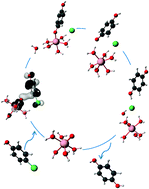Oxo iron(iv) as an oxidative active intermediate of p-chlorophenol in the Fenton reaction: a DFT study†
Abstract
Debate continues over which active species plays the role of oxidative agent during the

* Corresponding authors
a
Université de Lyon, Université Lyon 1 and CNRS, France
E-mail:
pierre.mignon@univ-lyon1.fr, henry.chermette@univ-lyon1.fr
b Institut des Sciences Analytiques, UMR 5280, Laboratoire de Chimie Physique Théorique, 43 bd.du 11 novembre 1918, 69622 Villeurbanne Cedex, France
c Institut de Recherches sur la Catalyse et l'Environnement de Lyon (IRCELyon), UMR5256 CNRS-UCBL1, 2 Av. Albert Einstein, 69626 Villeurbanne, France
Debate continues over which active species plays the role of oxidative agent during the

 Please wait while we load your content...
Something went wrong. Try again?
Please wait while we load your content...
Something went wrong. Try again?
P. Mignon, M. Pera-Titus and H. Chermette, Phys. Chem. Chem. Phys., 2012, 14, 3766 DOI: 10.1039/C2CP23231F
To request permission to reproduce material from this article, please go to the Copyright Clearance Center request page.
If you are an author contributing to an RSC publication, you do not need to request permission provided correct acknowledgement is given.
If you are the author of this article, you do not need to request permission to reproduce figures and diagrams provided correct acknowledgement is given. If you want to reproduce the whole article in a third-party publication (excluding your thesis/dissertation for which permission is not required) please go to the Copyright Clearance Center request page.
Read more about how to correctly acknowledge RSC content.
 Fetching data from CrossRef.
Fetching data from CrossRef.
This may take some time to load.
Loading related content
